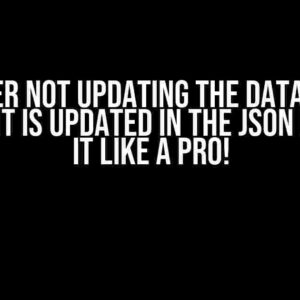Introduction
In the world of search engines and APIs, one of the most powerful tools at your disposal is SearchAnchor. With its ability to fetch and display data from various sources, SearchAnchor has become a staple in the digital landscape. However, one of the most common challenges faced by developers is displaying previous data fetched from an API using SearchAnchor. In this article, we’ll take you on a journey to master the art of SearchAnchor suggestion and show you how to display previous data fetched from an API.
Understanding SearchAnchor and API
Before we dive into the nitty-gritty of displaying previous data, it’s essential to understand the basics of SearchAnchor and API.
What is SearchAnchor?
SearchAnchor is a powerful search engine optimization (SEO) technique that helps improve the search engine ranking of a website by providing relevant and accurate search suggestions. It works by fetching data from various sources, including APIs, and displaying it in a user-friendly format.
What is an API?
An Application Programming Interface (API) is a set of defined rules that enable different applications to communicate with each other. APIs allow developers to fetch and manipulate data from external sources, making it an essential tool in modern web development.
Fetching Data from an API
Now that we have a basic understanding of SearchAnchor and API, let’s explore how to fetch data from an API using SearchAnchor.
Step 1: Choose an API
The first step in fetching data from an API is to choose a suitable API that provides the data you need. There are numerous APIs available, ranging from weather APIs to social media APIs. For this example, let’s use the OpenWeatherMap API, which provides real-time weather data.
Step 2: Register for an API Key
Once you’ve chosen an API, you need to register for an API key. The API key is a unique identifier that grants you access to the API’s data. To register for an API key, follow these steps:
- Go to the OpenWeatherMap API website and click on “Get API Key.”
- Fill in the registration form with your details.
- Verify your email address.
- Log in to your account and copy the API key.
Step 3: Make an API Request
Now that you have an API key, it’s time to make an API request using SearchAnchor. You can do this using the following code:
<script>
const apiKey = "YOUR_API_KEY";
const apiUrl = "http://api.openweathermap.org/data/2.5/weather";
const searchQuery = "London";
fetch(`${apiUrl}?q=${searchQuery}&appid=${apiKey}`)
.then(response => response.json())
.then(data => console.log(data))
.catch(error => console.error(error));
</script>
This code makes a GET request to the OpenWeatherMap API, passing in the search query and API key as parameters.
Displaying Previous Data Fetched from API
Now that we’ve fetched data from the API, let’s explore how to display previous data fetched from an API using SearchAnchor.
Step 1: Store the Data
To display previous data, you need to store the data fetched from the API in a cache or database. This allows you to retrieve the data later and display it to the user.
| Cache Option | Description |
|---|---|
| Local Storage | Stores data locally on the user’s device. |
| Session Storage | Stores data for the duration of the user’s session. |
| Database | Stores data in a remote database. |
For this example, let’s use Local Storage to store the data.
Step 2: Retrieve the Data
Once the data is stored, you can retrieve it using the following code:
<script>
const cache = window.localStorage;
const cachedData = cache.getItem("weatherData");
if (cachedData) {
console.log(cachedData);
} else {
console.log("No data found.");
}
</script>
This code retrieves the cached data from Local Storage using the `getItem()` method. If the data exists, it logs the data to the console; otherwise, it logs a message indicating that no data was found.
Step 3: Display the Data
Now that we’ve retrieved the data, let’s display it to the user. You can do this by creating a simple HTML template and populating it with the cached data.
<div id="search-results"></div>
<script>
const cache = window.localStorage;
const cachedData = cache.getItem("weatherData");
if (cachedData) {
const searchData = JSON.parse(cachedData);
const searchResults = document.getElementById("search-results");
searchResults.innerHTML = "";
searchData.forEach((item) => {
const result = document.createElement("div");
result.textContent = `${item.name} - ${item.main.temp}°C`;
searchResults.appendChild(result);
});
} else {
console.log("No data found.");
}
</script>
This code creates a simple HTML template and populates it with the cached data using JavaScript. The data is displayed in a list format, showing the name and temperature of each location.
Best Practices for SearchAnchor Suggestion
When it comes to SearchAnchor suggestion, there are several best practices you should follow to ensure optimal performance and user experience.
Use Relevant Data
Use relevant and accurate data that matches the user’s search query. This ensures that the user sees relevant suggestions that meet their needs.
Optimize for Mobile
Ensure that your SearchAnchor suggestion is optimized for mobile devices. This includes using a responsive design and ensuring that the data is easily readable on smaller screens.
Use Cache Efficiently
Use cache efficiently to reduce the load on your API and improve performance. This includes storing data in a cache or database and retrieving it only when necessary.
Provide Feedback
Provide feedback to the user on the data being fetched and displayed. This includes using loading indicators and error messages to indicate when data is being fetched or when an error occurs.
Conclusion
Displaying previous data fetched from an API using SearchAnchor is a powerful technique that can enhance the user experience and improve search engine ranking. By following the steps outlined in this article, you can master the art of SearchAnchor suggestion and provide your users with relevant and accurate data. Remember to follow best practices for SearchAnchor suggestion, including using relevant data, optimizing for mobile, using cache efficiently, and providing feedback to the user.Here are 5 questions and answers about “SearchAnchor suggestion show previous data fetched from API” in HTML format:
Frequently Asked Questions
Get your queries answered about SearchAnchor suggestions and previous data fetched from API!
Why do SearchAnchor suggestions show previous data fetched from API?
SearchAnchor suggestions show previous data fetched from API because it caches the results to provide a faster user experience. This caching mechanism allows the system to retrieve data quickly, reducing the load on the API and improving overall performance.
How often does SearchAnchor update its cached data?
SearchAnchor updates its cached data at regular intervals, typically every 24 hours. This ensures that users receive fresh and updated suggestions while maintaining a balance between data freshness and system performance.
Can I force SearchAnchor to fetch new data from the API instead of showing cached results?
Yes, you can force SearchAnchor to fetch new data from the API by using the “refresh” or “reload” feature. This will bypass the cached results and retrieve the latest data from the API, ensuring you receive the most up-to-date suggestions.
What are the benefits of caching data in SearchAnchor suggestions?
Caching data in SearchAnchor suggestions offers several benefits, including reduced API requests, faster response times, and improved overall system performance. This allows users to quickly access relevant suggestions, enhancing their search experience.
How does SearchAnchor handle errors when fetching data from the API?
SearchAnchor has built-in error handling mechanisms to handle cases where the API request fails or returns an error. In such scenarios, SearchAnchor will retry the request, and if the issue persists, it will display an error message to the user, ensuring a seamless and reliable search experience.





